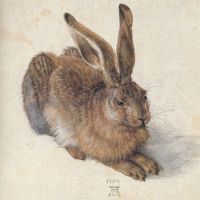Early this morning, I stepped out into my garden with a mug of tea to admire the view in the unseasonally glorious Easter Sunday weather. I was about to return to the house when I spotted a brown hare (Lepus europaeus) in the adjacent field. I have seen hares on the moors above my house many times, but this was a new one as far as species spotted from my garden was concerned. A good start to the day.

"An Easter Bunny," joked my partner, Jen, when I told her about the hare.
Which got me wondering what on earth the Easter Bunny was all about. It wasn't something I remembered from my childhood. Some silly, new-fangled American 'tradition' like trick or treat and pumpkins at Halloween, I thought. I couldn't have been more wrong:
It turns out that the impressive fecundity of hares (they breed like rabbits), and their famous courtship boxing in early spring, meant they were associated with the Anglo-Saxon goddess of spring, Eostre, whose name and festival was appropriated by the Christians and evolved into Easter. Some European countries still associate Easter with hares and not rabbits.
So Jen was right: I had seen a genuine Easter Bunny.